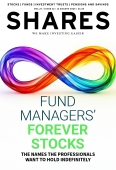Archived article
Please note that tax, investment, pension and ISA rules can change and the information and any views contained in this article may now be inaccurate.
Record numbers of US companies are beating revenue and earnings forecasts

As Shares went to print, over 90% of the companies in the S&P 500 index had posted their results for the second quarter with 81% reporting EPS (earnings per share) above consensus estimates according to data from FactSet Insight.
If the same proportion of companies has beaten forecasts by the time the last 10% or so of filings are in, it will not only be above the five-year and 10-year averages of 78% and 75% respectively, but it will mark the best quarterly reporting season since July to September 2023.
While more companies than normal are beating estimates, the average ‘beat’ is 8.4% which is below the five-year average of 9.1% although it tops the 6.9% average of the last 10 years.
Since the end of June, positive surprises from companies in the financial, communications services, information technology and consumer discretionary sectors have been the biggest contributors to the increase in overall earnings growth at the index level.
Coincidentally, 81% of companies have also reported second-quarter revenue above forecasts which tops both the five-year average of 70% and the 10-year average of 64% and if sustained would mark the highest percentage for a quarter since April to June 2021.
Overall, companies posted revenue 2.4% above the consensus, which once again beats the five- and 10-year averages, with upside surprises from the health care, communications services, information technology and consumer discretionary sectors making the largest contribution to the overall ‘beat’.
Only two sectors reported a drop in EPS, energy and materials, while energy was the only sector to make a negative contribution to revenue growth at the index level.
As we have said previously, all else being equal, companies’ ability to beat earnings – and for that matter revenue – forecasts largely comes down to where those forecasts are pitched, and it seems likely analysts are low-balling estimates due to the unknown impact of tariffs which is allowing more firms to surprise to the upside.
On the subject of tariffs, a new report from Goldman Sachs estimates up to the end of June, US companies had ‘eaten’ roughly two thirds of the impact of higher import duties, with US consumers absorbing 22% and foreign exporters shouldering 14% of the impact.
Although the analysis is still early-stage, the firm believes US consumers will go on to absorb up to 70% of the impact as companies pass on higher prices, which completely contradicts the narrative coming from the White House, so it will be interesting to see how markets react if that is the case.
Important information:
These articles are provided by Shares magazine which is published by AJ Bell Media, a part of AJ Bell. Shares is not written by AJ Bell.
Shares is provided for your general information and use and is not a personal recommendation to invest. It is not intended to be relied upon by you in making or not making any investment decisions. The investments referred to in these articles will not be suitable for all investors. If in doubt please seek appropriate independent financial advice.
Investors acting on the information in these articles do so at their own risk and AJ Bell Media and its staff do not accept liability for losses suffered by investors as a result of their investment decisions.
Issue contents
Exchange-Traded Funds
Feature
Great Ideas
News
- Eli Lilly shares under pressure after disappointing clinical trial results
- Recruiter Hays set to update expectations with shares at decade-low
- Record numbers of US companies are beating revenue and earnings forecasts
- Fresnillo up 180% year-to-date after latest strong results
- All eyes on second-quarter retail bellwether Walmart
- Bellway brings a ray of light to the housebuilders with its half-year update
 magazine
magazine








